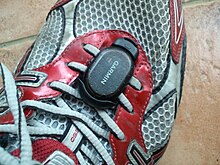| This article includes a list of references, related reading, or external links, but its sources remain unclear because it lacks inline citations. Please help improve this article by introducing more precise citations. (September 2024) (Learn how and when to remove this message) |

An inertial footpod is a device used to track running measurements such as speed, distance travelled, pace, etc., which would generally only be available on treadmills or with a GPS unit.
This device is usually small and attaches to a runner's foot. It uses one or more accelerometers and processes several times a second to compute speed.
One example is the foot pod employed by the Polar S625x running computer.
See also
- Musgrave Footprint
- Pedometer
References
- Runner's Edge, The. Human Kinetics. p. 19. ISBN 9781450409025.
Further reading
- Stirling, Ross; Fyfe, Ken; Lachapelle, Gérard (2005). "Evaluation of a New Method of Heading Estimation for Pedestrian Dead Reckoning Using Shoe Mounted Sensors". Journal of Navigation. 58 (1): 31–45. Bibcode:2005JNav...58...31S. CiteSeerX 10.1.1.470.4632. doi:10.1017/S0373463304003066. S2CID 16086241.
- Lowe, Shane; Ólaighin, Gearóid (2012). "The age of the virtual trainer". Procedia Engineering. 34: 242–7. doi:10.1016/j.proeng.2012.04.042.
- Camous, Fabrice; McCann, Dónall; Roantree, Mark (2008). Capturing Personal Health Data from Wearable Sensors. 2008 International Symposium on Applications and the Internet. Turku, Finland. pp. 153–6. doi:10.1109/SAINT.2008.67. ISBN 978-0-7695-3297-4.
- Young, C; Fleming, P. R.; Dixon, S; Carré, M. J. (2008). "Shoe Signature Monitoring for Advanced Running Technique (P145)". In Estivalet, Margaret; Brisson, Pierre (eds.). The Engineering of Sport 7. pp. 35–43. doi:10.1007/978-2-287-09413-2_5. ISBN 978-2-287-09412-5.
- Weyand, Peter G.; Kelly, Maureen; Blackadar, Thomas; Darley, Jesse C.; Oliver, Steven R.; Ohlenbusch, Norbert E.; Joffe, Sam W.; Hoyt, Reed W. (July 2001). "Ambulatory estimates of maximal aerobic power from foot-ground contact times and heart rates in running humans". Journal of Applied Physiology. 91 (1): 451–8. doi:10.1152/jappl.2001.91.1.451. PMID 11408463.